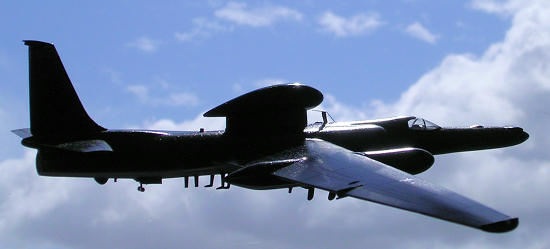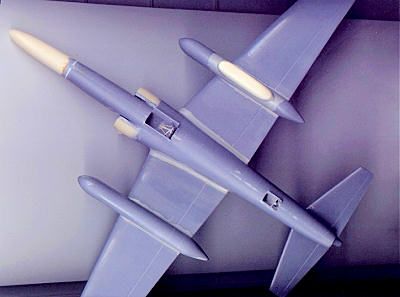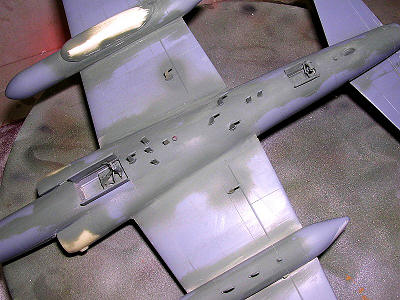
Special Hobby 1/72 U-2S 'Dragon Lady'
| KIT #: | ? |
| PRICE: | $ |
| DECALS: | |
| REVIEWER: | Carmel J. Attard |
| NOTES: | Short run kit with resin parts. |

| HISTORY |
The Lockheed U2 is a high altitude aircraft equipped with
optical reconnaissance equipment to conform in line with both the USAF and CIA
requirements. The aircraft was hardly heard of until one was shot down ove r
Russian territory and its pilot, Francis Gary Powell was sent to a Russian
prison. Until 1976, the shape of the aircraft remained basically the same since
introduced in 1956. The TR1 was a scaled up version which evolved in 1981.It was
capable of flying on very long distance flights and was capable of several
missions during the Gulf war of 1991sending vital information on the movement of
Iraqi troops. The U2/TR1 aircraft underwent several changes over the years and
was updated and modified several times to take the latest type of recce and also
ECM equipment for self defence. It conducted surveillance and reconnaissance spy
missions over Cuba, China, the Middle East and Eastern block countries,
operating from 70,000 ft altitude and could be best flown with auto pilot. I
had the opportunity to examine the TR1 from close quarters during the Leuchars
air show in Scotland way back in September 1991. The type was also reported
operating from bases as Mildenhall, Sigonella and Akrotiri.
r
Russian territory and its pilot, Francis Gary Powell was sent to a Russian
prison. Until 1976, the shape of the aircraft remained basically the same since
introduced in 1956. The TR1 was a scaled up version which evolved in 1981.It was
capable of flying on very long distance flights and was capable of several
missions during the Gulf war of 1991sending vital information on the movement of
Iraqi troops. The U2/TR1 aircraft underwent several changes over the years and
was updated and modified several times to take the latest type of recce and also
ECM equipment for self defence. It conducted surveillance and reconnaissance spy
missions over Cuba, China, the Middle East and Eastern block countries,
operating from 70,000 ft altitude and could be best flown with auto pilot. I
had the opportunity to examine the TR1 from close quarters during the Leuchars
air show in Scotland way back in September 1991. The type was also reported
operating from bases as Mildenhall, Sigonella and Akrotiri.
| THE KIT |
 The only
known previous manufacturer of the U2A and C version and later the TR1 to a
scale of 1/72 was Rareplanes who one of the principal forerunners of accurate
vac forms kit producers. These kits released in separate and different issues
were worth having in view of their high accuracy. I happened to see both kits
but was only able to make the early U2 release in due course. Some time later,
another manufacturer, this time Airfix issued an injection moulded U2 which like
the other two was produced to a scale of 1/72. This fell in favour to the
Rareplanes as the injection moulded kits are more popular but even so surplus
parts from the Rareplanes kit could be utilised to modify the Airfix U2 into a
camouflaged C version or a NASA U2 which differed in having an additional
electronics bay fairing along the upper fuselage and bulging out air intake
ducts. As for other scales, Italeri has made the kit of the TR1 to 1/48 scale.
The only
known previous manufacturer of the U2A and C version and later the TR1 to a
scale of 1/72 was Rareplanes who one of the principal forerunners of accurate
vac forms kit producers. These kits released in separate and different issues
were worth having in view of their high accuracy. I happened to see both kits
but was only able to make the early U2 release in due course. Some time later,
another manufacturer, this time Airfix issued an injection moulded U2 which like
the other two was produced to a scale of 1/72. This fell in favour to the
Rareplanes as the injection moulded kits are more popular but even so surplus
parts from the Rareplanes kit could be utilised to modify the Airfix U2 into a
camouflaged C version or a NASA U2 which differed in having an additional
electronics bay fairing along the upper fuselage and bulging out air intake
ducts. As for other scales, Italeri has made the kit of the TR1 to 1/48 scale.
 The last
kit to be produced in the series of this high altitude recce. Aircraft was the
U2S/ER2 by Special Hobby of the Czech Republic. This is a very welcome kit to a
scale of 1/72 which is very well detailed and comes mainly in grey plastic,
having a vac form canopy (two being supplied) and a large number of accurate
resin pieces. The kit is accompanied by complete assembly instructions which
will enable to make any of the three versions offered. The decal sheet, which is
produced by Propagteam is quite comprehensive and caters for all the three
versions on offer. These are for a RE2 used at the NASA Dryden Flight Research
Centre at Edwards AFB, in California which is in light grey and white scheme and
for two U-2S in overall matt black serving with the USAF 99 th RS, 9th
RW, at Beale Air Force Base in California. The box art depicts the NASA version
and serves as a very good source to refer to during application of the decals
for this version.
The last
kit to be produced in the series of this high altitude recce. Aircraft was the
U2S/ER2 by Special Hobby of the Czech Republic. This is a very welcome kit to a
scale of 1/72 which is very well detailed and comes mainly in grey plastic,
having a vac form canopy (two being supplied) and a large number of accurate
resin pieces. The kit is accompanied by complete assembly instructions which
will enable to make any of the three versions offered. The decal sheet, which is
produced by Propagteam is quite comprehensive and caters for all the three
versions on offer. These are for a RE2 used at the NASA Dryden Flight Research
Centre at Edwards AFB, in California which is in light grey and white scheme and
for two U-2S in overall matt black serving with the USAF 99 th RS, 9th
RW, at Beale Air Force Base in California. The box art depicts the NASA version
and serves as a very good source to refer to during application of the decals
for this version.
| CONSTRUCTION |
 The
assembly of the kit this may not be so simple a task as the first impression may
give. There are several alternative parts in resin and a thorough study of the
instructions provided is recommended even before one select the version
favoured. The parts have very fine engraved panel lines but there are no guides
for fit between parts such as those of the fuselage halves. So for simplicity
one can produce his own by fitting plastic strips to one side of the fuselage
parts etc as shown in the accompanying pictures. There may also be difficulty
with fitting of the wings to the fuselage and I found it useful to fit a piece
of plastic strip strong enough to form a c
The
assembly of the kit this may not be so simple a task as the first impression may
give. There are several alternative parts in resin and a thorough study of the
instructions provided is recommended even before one select the version
favoured. The parts have very fine engraved panel lines but there are no guides
for fit between parts such as those of the fuselage halves. So for simplicity
one can produce his own by fitting plastic strips to one side of the fuselage
parts etc as shown in the accompanying pictures. There may also be difficulty
with fitting of the wings to the fuselage and I found it useful to fit a piece
of plastic strip strong enough to form a c ross
bar that will hold the main wings to the fuselage and secure them in the correct
angle. In spite of all, this is an impressive kit which with all the resin parts
given caters for all the details to intakes, antennae, dorsal random, position
of different coloured lights carried on fuselage, wings and tail fin besides
cockpit interior detail.
ross
bar that will hold the main wings to the fuselage and secure them in the correct
angle. In spite of all, this is an impressive kit which with all the resin parts
given caters for all the details to intakes, antennae, dorsal random, position
of different coloured lights carried on fuselage, wings and tail fin besides
cockpit interior detail.
Almost all joints need a good deal of filling and so a supply of this is bought with the kit unless you have a tube of it already. As far as sanding goes I have first covered the intricate panel lines with masking tape in order not to spoil these during sanding of the excess filler. The stage that followed was adding the numerous L-shaped antennae to the under-fuselage areas and wing roots areas.
| COLORS & MARKINGS |
This was a somewhat simple task as it was finished overall black with very fine smooth sanding in between the first and subsequent coats to produce the desired sheen prior to putting on the decals. The cockpit interior was painted light grey with colour to the seat, coaming as per kit instruction. Intakes and wheel wells were painted white and other detail in grey and black. The painted model was finally given a semi matt coat of clear Revell varnish to give the desired surface sheen.
| CONCLUSIONS |
 This
was another one of those kits which when complete indicating an overwhelming
difference in shape from the early U2 from which it has evolved. The difference
in size can be seen in the accompanying photos of the two versions of the U2.
This is a must for those who like me have taste for high altitude
surveillance/reconnaissance and ECM aircraft so often heard of in past decades
of electronic warfare.
This
was another one of those kits which when complete indicating an overwhelming
difference in shape from the early U2 from which it has evolved. The difference
in size can be seen in the accompanying photos of the two versions of the U2.
This is a must for those who like me have taste for high altitude
surveillance/reconnaissance and ECM aircraft so often heard of in past decades
of electronic warfare.
April 2008
Copyright ModelingMadness.com
If you would like your product reviewed fairly and quickly, please contact the editor or see other details in the Note to Contributors.
Back to the Review Index Page 2017